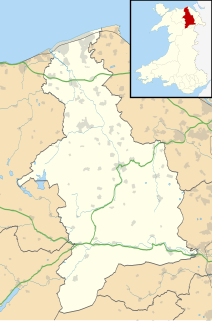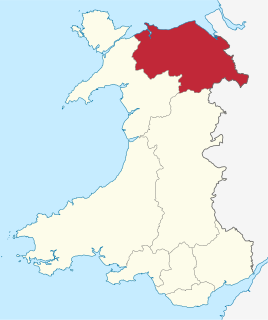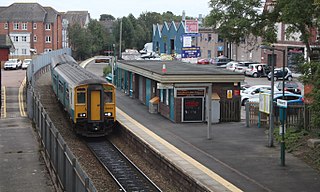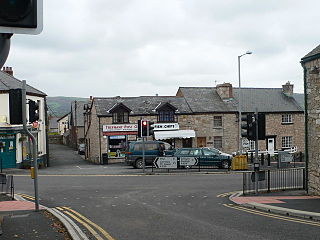
Denbighshire is a county in the north-east of Wales. Its borders differ from the historic county of the same name. This part of Wales contains the country's oldest known evidence of habitation – Pontnewydd (Bontnewydd-Llanelwy) Palaeolithic site has Neanderthal remains of some 225,000 years ago. Castles include Denbigh, Rhuddlan, Ruthin, Castell Dinas Bran and Bodelwyddan. St Asaph, one of Britain's smallest cities, has one of its smallest Anglican cathedrals.

Clwyd is a preserved county of Wales, situated in the north-east corner of the country; it is named after the River Clwyd, which runs through the area. To the north lies the Irish Sea, with the English ceremonial counties of Cheshire to the east and Shropshire to the south-east. Powys and Gwynedd lie to the south and west respectively. Clwyd also shares a maritime boundary with Merseyside along the River Dee. Between 1974 and 1996, a slightly different area had a county council, with local government functions shared with six district councils. In 1996, Clwyd was abolished, and the new principal areas of Conwy County Borough, Denbighshire, Flintshire and Wrexham County Borough were created; under this reorganisation, "Clwyd" became a preserved county, with the name being retained for certain ceremonial functions.

Penarth railway station is the railway station serving the town of Penarth in the Vale of Glamorgan, South Wales. It is the terminus of Network Rail's Penarth branch running from Cogan Junction to Penarth station, 1 mile 12 chains from the junction and 2 miles 67 chains south of Cardiff Central station. The Penarth branch ran from Cogan Junction to Biglis Junction, a rail mileage of 5 miles 65 chains and was officially closed beyond Penarth after the last passenger train ran on Saturday 4 May 1968.

Troed-y-rhiw railway station is a railway station serving the village of Troed-y-rhiw in Merthyr Tydfil, Wales. It is located on the Merthyr branch of the Merthyr Line. Passenger services are provided by Transport for Wales.
The Mold and Denbigh Junction Railway was a railway company that built a 15+3⁄4-mile (25.3 km) railway line in North Wales. It formed a link between the Mold Railway and the Vale of Clwyd Railway towards Rhyl.
The Denbigh, Ruthin and Corwen Railway was a standard gauge railway line that connected Corwen with Denbigh via Ruthin in North Wales.

Ebbw Vale Town railway station serves the town centre of Ebbw Vale in Blaenau Gwent, Wales, serving as the terminus of the Ebbw Valley Railway.
The Vale of Clwyd Railway (VoCR) was a standard-gauge line which connected the towns of Rhyl and Denbigh via St Asaph in North Wales.
Rhuddlan was a railway station located in Rhuddlan, Denbighshire. It first opened in 1858 as part of the Vale of Clwyd Railway, and afterwards under the auspices of several different companies. The station closed to passengers on 19 September 1955, some seven years after nationalisation.

St Asaph railway station served the city of St Asaph in Denbighshire, Wales. It was opened by the Vale of Clwyd Railway on 5 October 1858 and closed on 19 September 1955. The station building and northbound platform are now a private residence.

Trefnant is a village and community in Denbighshire, Wales. It is located on the A525 road in the Vale of Clwyd, about halfway between St Asaph (Llanelwy) to the north and Denbigh to the south. At the 2001 Census, the community had a population of 1,409, increasing to 1,581 at the 2011 Census.
Dyffryn Clwyd was a cantref of Medieval Wales and from 1282 a marcher lordship. In 1536, it became part of the new county of Denbighshire. The name means Vale of Clwyd in English and is still the name for that region of north Wales in modern Welsh. Dyffryn Clwyd was one of the cantrefi of Perfeddwlad, and itself was made up of three commotes, Colion, Dogfeiling and Llannerch.
The Kinmel Camp Railway, otherwise known as the Kinmel Park Railway was a 3-mile (4.8 km) long standard gauge railway built to serve Kinmel Camp near Rhyl in north Wales.

Beaufort railway station was a station on the London and North Western Railway's Heads of the Valleys line serving the town of Beaufort in the Welsh county of Brecknockshire.
The Dyserth branch line was a short standard-gauge mineral railway between the northern end of the Clwydian Range at Dyserth and the North Wales Coast Line at Prestatyn. The line was constructed by the London and North Western Railway in 1869; it was built to carry quarried stone and coal. The rise of tourism led to the introduction of a passenger service in 1905. There were stations at Dyserth and Meliden, and basic halts were built at other stopping places. Competition from road transport led to the passenger service being withdrawn in 1930. With the eventual demise of all the mineral industries around Dyserth the entire line was closed in September 1973.
Ebbw Vale railway station was a station on a short branch from the London and North Western Railway's Heads of the Valleys line which served the town of Ebbw Vale in the Welsh county of Monmouthshire.

Dyserth railway station served the village of Dyserth, Flintshire, Wales. It was the southern terminus of the 2 miles 70 chains (4.6 km) Dyserth branch, most of which is now a public footpath. At its peak Dyserth had passengers in the thousands. In 1930 the line and station closed for passengers in the face of road competition. At one point fourteen trains a day had shuttled along the line. Although the station has long been demolished, a crane from the station has been installed at the end of the walk as a feature of historical interest, as have two pieces of track at Chapel Street.

Llanerch Hall, Trefnant, Clwyd, Wales, is a country house with medieval origins. It was rebuilt twice at the beginning and at the end of the 17th century, was again rebuilt in the 19th century, and further modified in the 20th. The hall is now divided into flats, each with its own Grade II* listing. The parkland, now a golf course, conceals traces of a late 17th century Italianate terraced garden that rivalled those at Powis Castle. The gardens were entirely destroyed in the 19th century rebuilding. The house remains privately owned.
Lloyd Williams and Underwood was a firm of architects based in Denbigh and active mostly in North Wales in the second half of the 19th century. The partners were Richard Lloyd Williams, formerly a pupil of Thomas Fulljames, and Martin Underwood, who was also county surveyor for Denbighshire. Several of their designed now have listed status.
Llannerch was a commote in the cantref of Dyffryn Clwyd which later became the Marcher Lordship of Ruthin. Situated in an area south of Ruthin the commote covered an area of 9,000 acres which included the parishes of Llanfair Dyffryn Clwyd and Llanelidan and 19 townships. Much of the land within the commote was owned by the Bishopric of Bangor.










